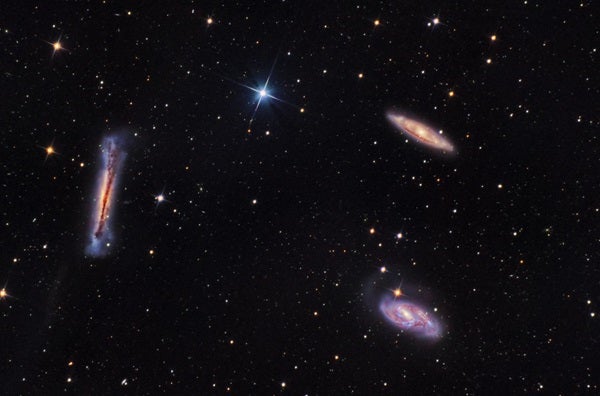A twin treat, M65 (top right) and M66 (bottom right) in Leo are arguably the most dynamic galaxy pair in the northern night sky, next to M81 and M82 in Ursa Major. Under a dark sky, binoculars will show them as two roughly magnitude 9 glows 20′ apart. Together with the dimmer edge-on spiral galaxy NGC 3628 (35′ to the northeast), they form the famed Leo Triplet of galaxies. All lie about 35 million light-years distant, in the Leo Spur — a little gathering of galaxies between the Local Group and Virgo Cluster. We see all three galaxies presented at different viewing angles, allowing us to inspect their spiral structure from different perspectives.
Charles Messier discovered both M65 and M66 in 1780, midway between Theta (θ) and Iota (ι) Leonis, noting they were “in the same field of view.”
In 1848, William Parsons, Earl of Rosse, resolved M65 into a “spiral or annular arrangement.” He later noticed dark lanes on either side of the nucleus. Indeed, the inclination of M65 is nearly optimal to show the galaxy’s dust silhouette, which traces a well-defined spiral pattern with two main arms. At its center lies a diffuse nucleus and bar embedded in a tiny central bulge. Through a moderate-sized telescope at 70x, its spiral structure requires attention — though the pattern appears coiled north of the nucleus, the southern disk region requires larger apertures to resolve.
M66, on the other hand, is a Milky Way-sized barred galaxy that sports prodigious dust, a displaced core, and grand spiral arms. One of these arms is “hooked,” thanks to distortions suffered in a gravitational war with NGC 3628. A fantastic 400,000-light-year-long tidal tail has also been detected between these two galaxies, the result of an encounter a billion years ago.
Through a telescope at moderate magnifications, M65 appears oval-shaped and quite large compared to M66, which is a much more difficult object to study. M66’s bright nuclear region stands out the most, with extensions that form the “trunk” of its S-shaped spiral structure, which large telescopes will show as soft strips of dappled light.
Make sure to explore Astronomy’s full list of 101 cosmic objects you must see. New entries will be added each week throughout 2022.
To get the latest astronomical news and observing content delivered directly to your door, subscribe to Astronomy magazine today!










